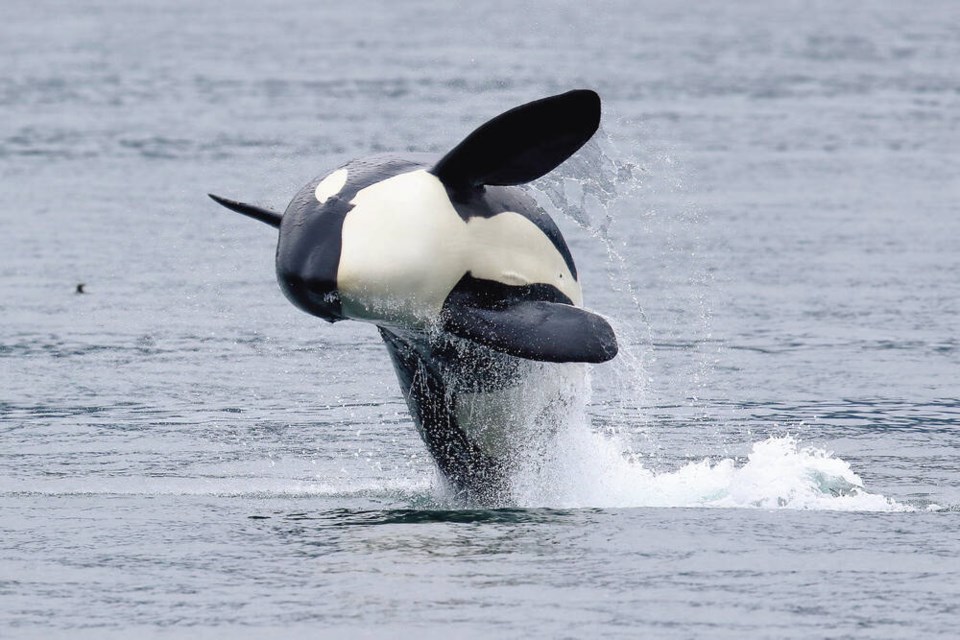She’s known as T37A, and was recently nicknamed Volker.
But whale watchers in the Salish Sea fondly refer to the 27-year-old Bigg’s orca as the “baby machine.”
Volker has produced five calves since 2007 — a high rate considering orcas have an 18-month gestation period, second only to the elephant in the animal kingdom.
And she’s a big reason why there’s a healthy population of Bigg’s orcas — also known as transients — flooding the Salish Sea these days.
“They are thriving,” said Erin Gless, executive director of the Pacific Whale Watch Association.
She said unlike the southern resident killer whales, which only eat chinook salmon and are struggling, Bigg’s orcas eat seals, sea lions and porpoises. And they’ve been finding plenty of food in the waters on our doorstep.
The Orca Behaviour Institute based in Friday Harbor, Washington, says the Bigg’s orcas are in the Salish Sea in record numbers this year.
As of Monday, there have been 793 sightings, eclipsing the previous record of 747 sightings in 2019 — with more than four months remaining in the year.
The Pacific Whale Watch Association defines a “sighting” as a report of a unique group of whales on any given day.
Monika Wieland Shields, director of the Orca Behaviour Institute, said more than 70 Bigg’s killer whales were documented in the last month alone, using markings on their dorsal fins and backs. More than 30 were spotted over the Labour Day weekend.
Paul Pudwell of Sooke Coastal Explorations said he came across seven families of Bigg’s killer whales during a three-hour excursion on Saturday — 26 orcas in total. “I’ve never seen so many Bigg’s at once,” said Pudwell. “It was a special day.”
He spotted seven at Pedder Bay, and the rest in and around Race Rocks.
“It’s a regular haulout for seals and it’s pupping season … it’s easy pickings for these whales,” Pudwell said.
Gless said based on data collected by the Department of Fisheries and Oceans, there are 400 to 500 Bigg’s orcas ranging from California to Alaska, with about 350 of those regularly making their way into the Salish Sea, which includes the Puget Sound, Strait of Georgia, Strait of Juan de Fuca and the San Juan Islands.
She said an abundance of food has led to the births of more than 130 calves over the past decade, a population growth rate of more than 4% a year. The salmon-eating southern resident whales, meanwhile, are down to 74 animals in three pods with the loss this summer of a 35-year-old male named Cappuccino.
Another southern resident, a female named J56 Tofino, was recently observed by scientists to be in poor health, and deemed “vulnerable” by the Washington Department of Fish and Wildlife.
The southern residents made brief appearances here in April and July, but left soon after arriving, likely because of the lack of salmon. Scientists estimate they are heading north and south in search of healthier chinook stocks.
Pudwell said many of the southern residents are learning to adapt by staying along “the salmon highway,” a broad lane about 60 kilometres offshore from the Island where chinook are returning to rivers to spawn.
The contrast in health between the Bigg’s and southern residents is striking, Gless said. “Bigg’s prove that killer whales can thrive in this region, so long as there is food. If we can restore local salmon populations, we have hope that southern residents can recover. The priority has to be getting them more food.”
Gless said the rising seal population over the past decade has “really brought the Bigg’s into our area … and it’s really exploded over the past five years.”
Once referred to as transient killer whales, the orcas have become known as Bigg’s by the whale-watching and research communities after orca research pioneer Dr. Michael Bigg.
Gless said the research community is now undertaking the “huge task” of giving names to the letter and numbers assigned each Bigg’s orca.
About 100 have been named so far, including Volker, the prolific mother who is often still nursing when she’s breeding.
“Giving them names makes a huge difference to people,” said Gless. “It brings a different response from people who see them.”
Bigg’s killer whales are now one of the primary types of whales seen by local whale watchers. With an almost daily presence, the name “transient” no longer seems fitting, said Gless.



